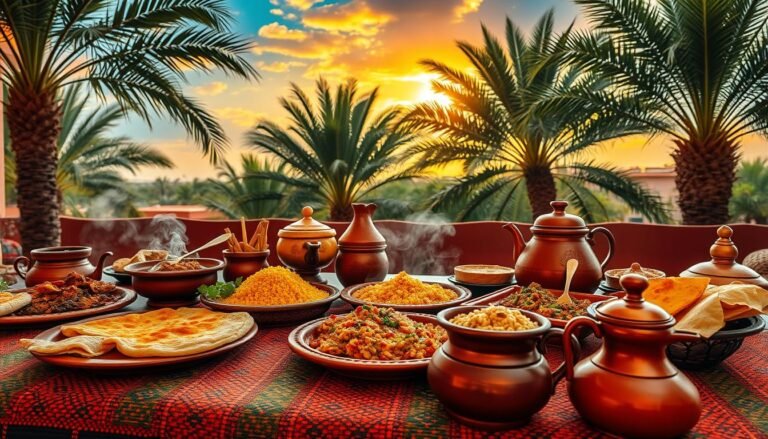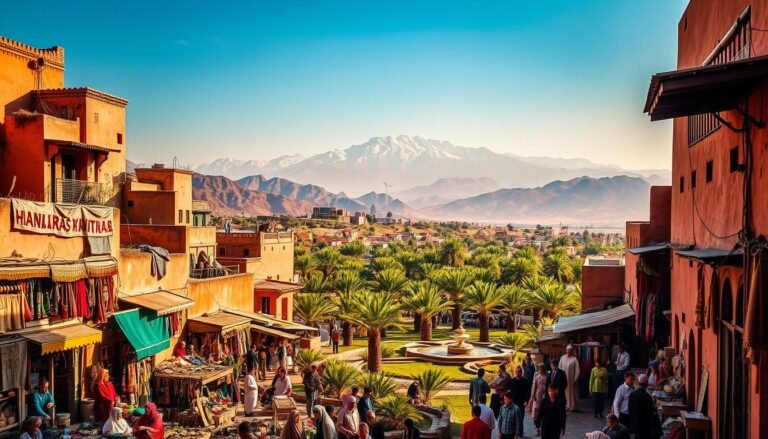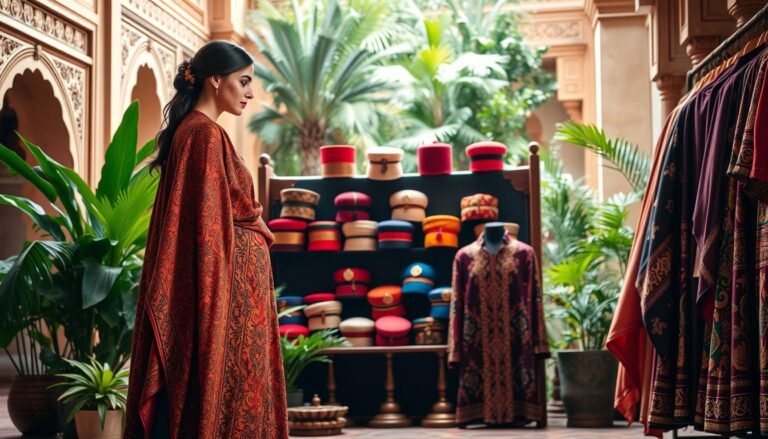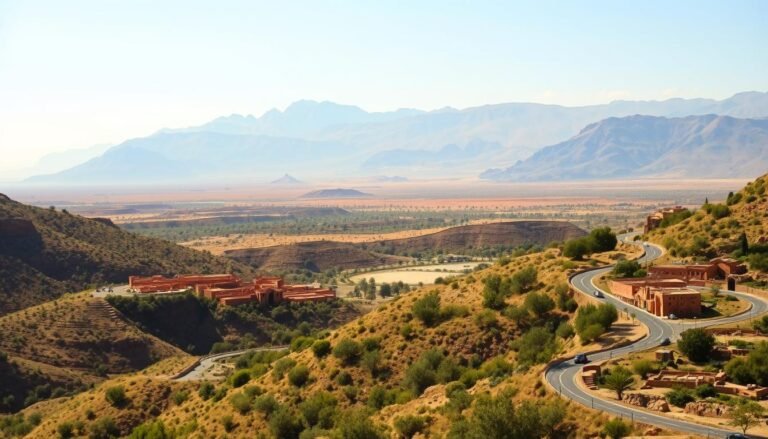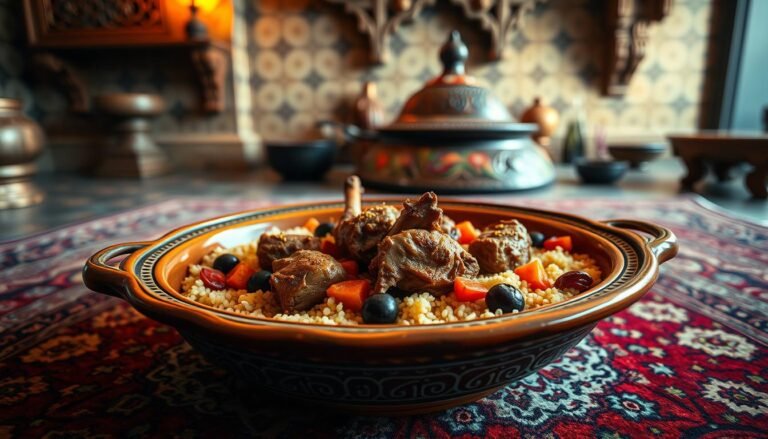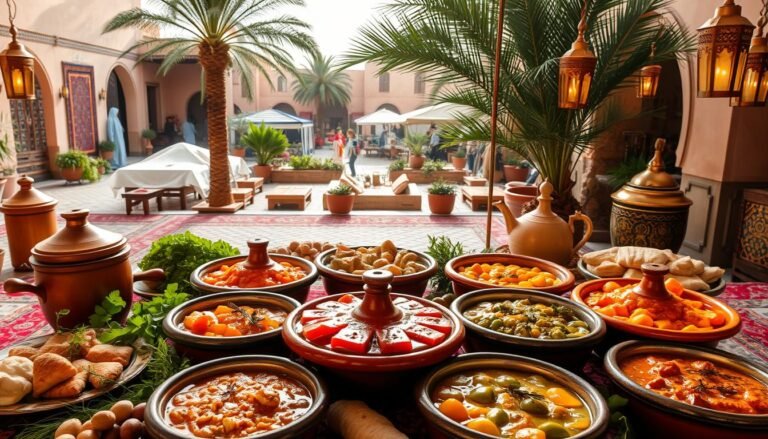Discover the Enchanting Traditions of Morocco
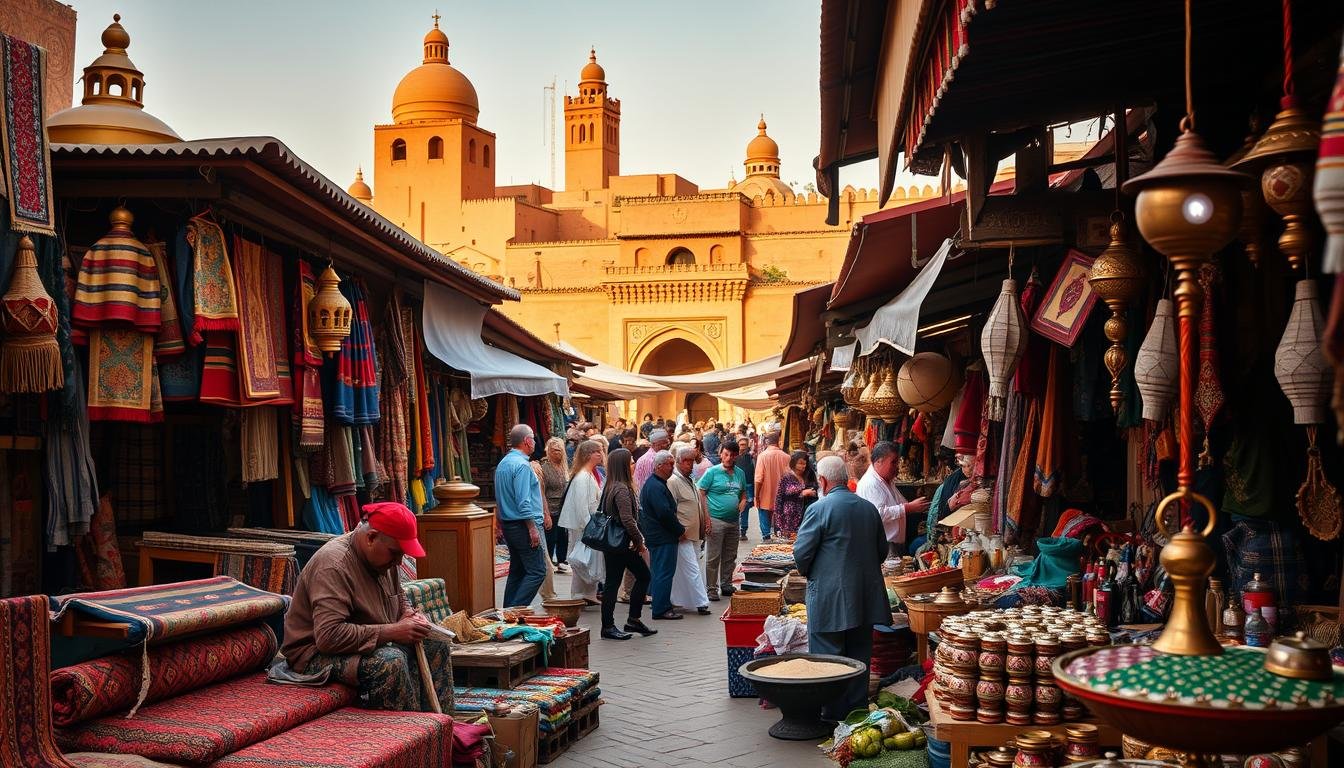
Imagine stepping into a world where the past and present intertwine seamlessly. Welcome to Morocco, a country where every corner tells a story of rich cultural heritage. This enchanting land is a vibrant mosaic of Arab, Berber, and Andalusi influences, creating a unique cultural tapestry that captivates the senses.
At the heart of Morocco’s charm lies its deep-rooted traditions. From the bustling souks to the serene landscapes, every experience is a testament to the country’s enduring legacy. The call to prayer from ancient mosques, the aroma of spices in the air, and the warmth of mint tea shared among friends all paint a picture of a culture that is both timeless and ever-evolving.
As we delve into the world of Moroccan culture, we uncover a society where ancient customs and contemporary life coexist harmoniously. Whether it’s the intricate craftsmanship of traditional Moroccan art or the lively celebrations that bring communities together, there’s no shortage of inspiration in this captivating country.
Key Takeaways
- Morocco is a unique blend of Arab, Berber, and Andalusi influences.
- The country seamlessly combines ancient traditions with modern life.
- Traditional Moroccan art, cuisine, and celebrations are central to its culture.
- Morocco’s cultural heritage is a testament to its rich history.
- The country offers a vibrant mix of historical and contemporary experiences.
An Introduction to Morocco’s Enchanting Traditions
Step into a world where the past and present blend harmoniously. Morocco’s rich history has shaped its customs and social life, creating a unique cultural landscape. From ancient practices to contemporary celebrations, every aspect of Moroccan life is deeply rooted in its historical timeline.
Exploring the Rich Tapestry of Moroccan Culture
Significant events and time-honored practices are woven into the fabric of Moroccan society. Family and community events play a vital role in preserving cultural life, ensuring that traditions are passed down through generations. These gatherings not only strengthen social bonds but also highlight the importance of shared experiences in Moroccan society.
Our Journey Through History and Tradition
The people of Morocco have maintained a distinctive way of life, deeply rooted in tradition and history. This blend of past and present creates a vibrant cultural identity. As we explore Morocco’s heritage, we uncover a society where history and contemporary life coexist, offering a fascinating glimpse into a culture that honors its roots while embracing the future.
The Foundation of Traditional Morocco: History and Influences
Centuries of rich history have shaped the cultural landscape of this enchanting land. From ancient Berber settlements to the influences of Arab and Andalusi cultures, each era has left an indelible mark.
Ancient Roots and Berber Legacy
The Berbers, indigenous to the region, laid the groundwork for Morocco’s distinct identity. Their communal granaries, known as igoudar, stand as testaments to their ingenuity and communal spirit. The Middle Atlas mountains, with their rugged terrain, cradled these early societies, fostering resilience and resourcefulness.
Arab, Andalusi, and Western Mediterranean Impacts
The 7th century Arab conquest introduced Islam and a wealth of spices, forever altering local cuisine and culture. The Andalusians, expelled from Spain, brought sophisticated architectural styles and musical traditions. Over the years, these influences intertwined, creating a vibrant cultural tapestry.
| Period | Key Contributions |
|---|---|
| 7th Century | Introduction of Islam and spices |
| Almoravid Dynasty | Unified vast territories |
| Almohad Dynasty | Advanced architectural developments |
| Marinid Dynasty | Golden age in Fez |
Each century has woven its thread into the fabric of Morocco’s heritage, creating a region of unparalleled diversity and richness.
The Artistic Heart of Morocco: Architecture, Literature, and Visual Arts
Discover the captivating blend of cultures that define Morocco’s artistic identity. From the intricate zellij tiles to the soaring arches, Moroccan art is a testament to the fusion of Arab, Berber, and Andalusian influences. This rich cultural tapestry is evident in every corner of the country, from the bustling souks to the serene riad gardens.
Stunning Architectural Masterpieces and Souks
One of the most iconic examples of Morocco’s architectural brilliance is the Saadian Tombs in Marrakech. With their delicate marble and mosaic work, these tombs reflect the refined artistry of the Saadian dynasty. Similarly, the al-Attarine Madrasa in Fez, known for its intricate tilework and calligraphy, stands as a masterpiece of Moroccan craftsmanship.
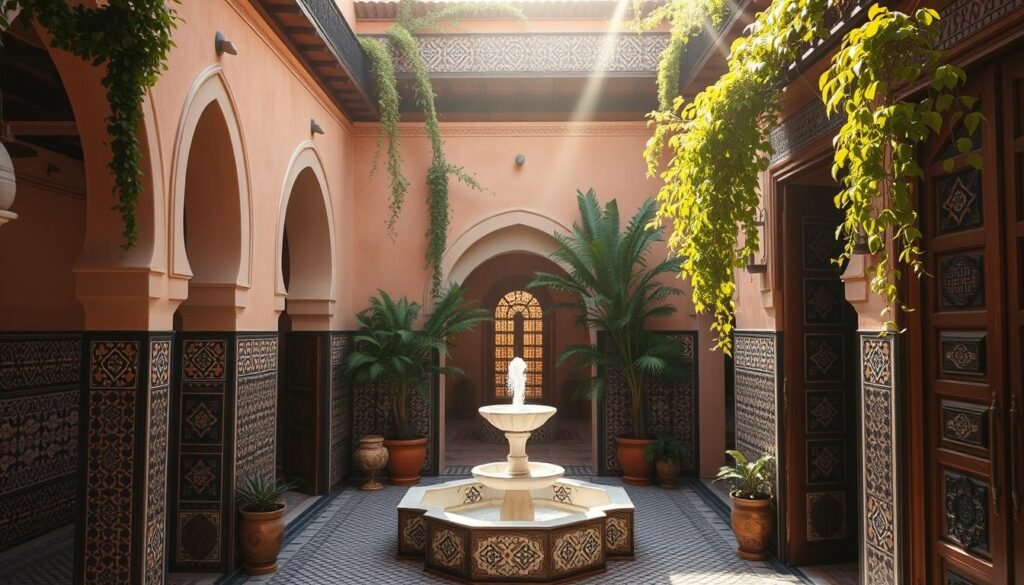
Moroccan Literature and Modern Art Movements
Moroccan literature has also evolved, blending traditional storytelling with contemporary themes. Modern artists are redefining traditional styles, creating a vibrant art scene that attracts global attention. This evolution showcases Morocco’s ability to honor its past while embracing innovative artistic expressions.
Savoring Moroccan Flavors: A Culinary Journey
Embark on a journey through the vibrant world of Moroccan cuisine, where every dish tells a story of cultural fusion and heritage. This culinary landscape is a delightful blend of Arab, Berber, and Mediterranean influences, creating a unique flavor profile that captivates the senses.
Signature Dishes and Spices
At the heart of Moroccan cuisine lies an array of signature dishes, each showcasing the country’s rich culinary heritage. Tagine, a slow-cooked stew named after the clay pot in which it’s prepared, is a cornerstone of Moroccan cooking. Whether it’s lamb tagine with apricots or spicy fish tagine, each variation reflects regional diversity. Couscous, traditionally served on Fridays, is more than just a meal—it’s a symbol of togetherness and family bonding.
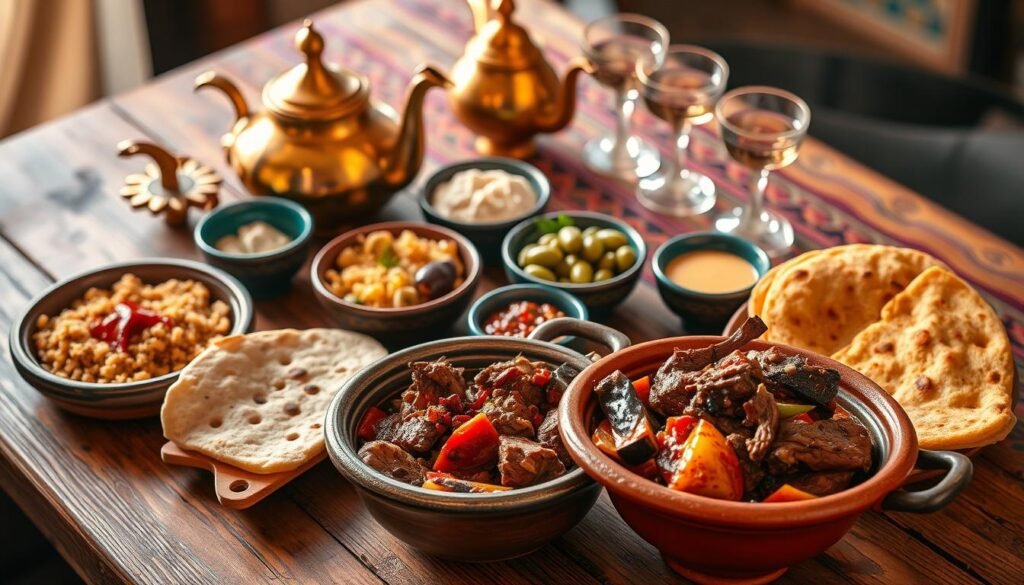
The Cultural Role of Mint Tea and Communal Meals
Mint tea, often referred to as ‘Moroccan whiskey,’ holds a special place in the culture. This refreshing brew is not just a drink but a symbol of hospitality and friendship. Communal meals are central to Moroccan life, fostering a sense of community and togetherness. Every dish is prepared with care, reflecting the passion and pride in preserving culinary traditions.
Resonating Rhythms: Music, Dance, and Festivals
Vibrant melodies and rhythmic beats form the heartbeat of Morocco’s cultural identity. Music and dance here are not just forms of entertainment but a way of expressing history, spirituality, and community bonds. Every note and step tells a story, reflecting the country’s rich heritage.
The Influence of Andalusian and Chaabi Music
Andalusian music, known as Al-Ala, traces its roots to medieval Al-Andalus. This sophisticated genre, featuring instruments like the oud and qanun, has deeply influenced Morocco’s musical landscape. Chaabi music, with its lively rhythms, emerged from urban working-class neighborhoods, addressing themes of love and social issues. Both genres have evolved over the day-to-day life and holidays, shaping festival celebrations across various areas, including the High Atlas.
Celebratory Festivals and Traditional Performances
Festivals in Morocco are a celebration of music, dance, and communal joy. The Essaouira Gnawa and World Music Festival is a prime example, attracting global artists and audiences. In the High Atlas, traditional performances during significant occasions bring communities together. These events transform specific places into vibrant cultural hubs, showcasing the deep connection between music, dance, and celebration.
Everyday Life and Cultural Etiquette in Morocco
Everyday life in Morocco is a beautiful blend of cultural customs and modern practices. The way people dress, interact, and celebrate reflects a deep respect for tradition while embracing contemporary life.
Daily Customs and Traditional Clothing
Traditional clothing plays a significant role in Moroccan daily life. The djellaba and kaftan are staples, worn by both women and men for their comfort and cultural significance. These garments are often adorned with intricate patterns, making them a symbol of identity and heritage.
Modesty is key in Moroccan culture, especially in rural areas. While women often opt for long dresses and headscarves, men may wear traditional robes. In urban settings, Western attire is more common, though still modest.
Respectful Interactions and Celebratory Etiquette
Visitors should understand local customs to interact respectfully. Removing shoes before entering a home is a sign of respect, as is using the right hand for eating and giving items. The traditional greeting involves a handshake with the right hand, sometimes accompanied by a light cheek touch among same-gender individuals.
Mint tea is central to social interactions. It’s not just a drink but a symbol of hospitality. Refusing an offer of mint tea can be seen as disrespectful, so it’s best to accept graciously.
| Aspect | Customs |
|---|---|
| Clothing | Djellaba and kaftan for modesty |
| Interactions | Remove shoes at home; right hand for eating |
| Special Occasions | Mint tea as a sign of hospitality |
Language and non-verbal cues also matter. While Arabic and French are widely spoken, learning a few phrases in Arabic can enhance interactions. Body language should be respectful, avoiding public displays of affection.
These customs connect Morocco’s past with its present, creating a vibrant tapestry of life. Understanding and respecting these traditions offers insights into the daily life and cultural identity of the Moroccan people.
Conclusion
As we conclude our journey through the rich tapestry of Moroccan traditions, we reflect on the vibrant blend of history, culture, and cuisine that defines this enchanting land. The perfectly spiced meat dishes, the aromatic hint of cinnamon, and the refreshing touch of mint all tell a story of a food heritage that is both flavorful and meaningful.
Every aspect of Moroccan life, from its delicious food to its lively festivals, contributes to a unique way of living. The harmony between culinary excellence and cultural legacy is a testament to the enduring spirit of Morocco. As we wrap up our exploration, we invite you to appreciate the seamless blend of traditions and modern influences that make this country so captivating.
Let us cherish the memories of this journey, where every dish, every celebration, and every custom reflects a deep connection to the past while embracing the future. Morocco’s story is one of unity, diversity, and the timeless beauty of its cultural heritage.

